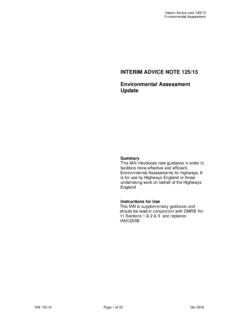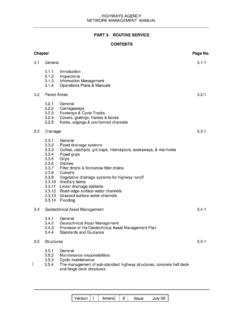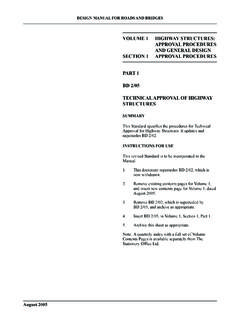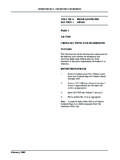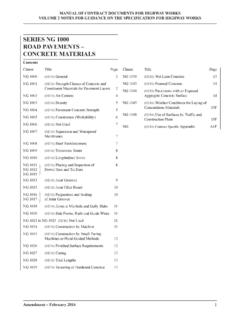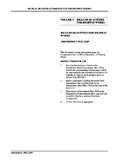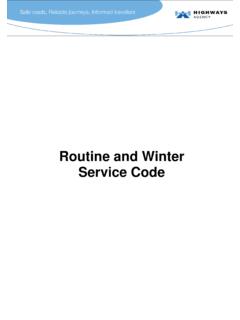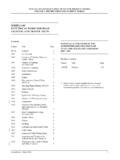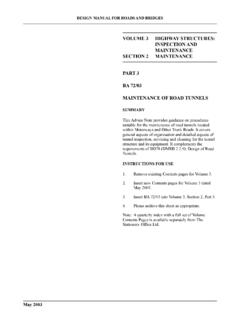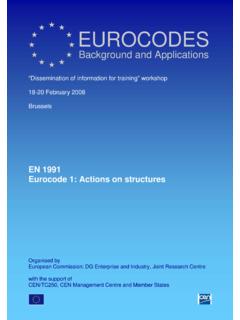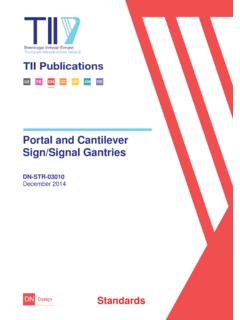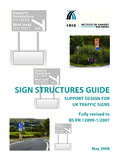Transcription of BD 2/12 - Standards for Highways
1 Volume 1 highway STRuCTuReS: approval PRoCeDuReS AND GeNeRAl DeSIGN SeCTIoN 1 approval PRoCeDuReSPART 1BD 2/12 technical approval oF highway STRuCTuReSSummARYThis Standard specifies the procedures for technical approval for highway Structures. It updates and supersedes BD 2 FoR uSeThis revised Standard is to be incorporated in the This document supersedes BD 2/05, which is now Remove existing contents pages for Volume 1, and insert new contents page for Volume 1, dated May Remove BD 2/05, which is superseded by BD 2/12, and archive as Insert BD 2/12, in Volume 1, Section 1, Part Archive this sheet as : A quarterly index with a full set of Volume Contents Pages is available separately from The Stationery Office mANuAl FoR RoADS AND BRIDGeSmay 2012 DeSIGN mANuAl FoR RoADS AND BRIDGeSBD 2/12 volume 1, Section 1, Part 1 technical approval of highway StructuresSummary: This Standard specifies the procedures for technical approval for highway Structures.
2 It updates and supersedes BD 2 Highways AGeNCYTRANSPoRT SCoTlAND WelSH GoveRNmeNT llYWoDRAeTH CYmRuTHe DePARTmeNT FoR ReGIoNAl DeveloPmeNT NoRTHeRN IRelANDmay 2012volume 1 Section 1 Part 1 BD 2/12 ReGISTRATIoN oF AmeNDmeNTSA mend NoPage No Signature & Date of incorporation of amendmentsAmend No Page NoSignature & Date of incorporation of amendments Registration of Amendmentsmay 2012volume 1 Section 1 Part 1 BD 2/12 ReGISTRATIoN oF AmeNDmeNTSA mend NoPage No Signature & Date of incorporation of amendmentsAmend No Page NoSignature & Date of incorporation of amendments Registration of Amendmentsvolume 1 highway STRuCTuReS: approval PRoCeDuReS AND GeNeRAl DeSIGN SeCTIoN 1 approval PRoCeDuReSPART 1BD 2/12 technical approval oF highway STRuCTuReSContentsChapter1. Introduction2. General Requirements and Principles3. Bridges and Other highway Structures4. Temporary Works5. Road Tunnel and Service Tunnel Structures6.
3 Mechanical and Electrical Installations7 References8. EnquiriesAnnex A Model approval in Principle FormsAnnex B Notes for compiling technical approval SchedulesAnnex C Model CertificatesAnnex D Proprietary Manufactured StructuresAnnex E Special Requirements for Overseeing Organisations concerning Third Party Proposals of Temporary Works or Temporary StructuresAnnex F Use of Interim Requirements for technical approval of highway Structures in English DBFO schemeDeSIGN mANuAl FoR RoADS AND BRIDGeSmay 2012may 2012volume 1 Section 1 Part 1 BD 2/121. This Standard specifies the technical approval (TA) procedures for highway structures on motorways and other trunk roads or designated Major changes in this version of BD 2 are (all clause references quoted are for this version of BD 2 unless stated otherwise): Amended clauses to make reference to the Overseeing Organisation s current requirements for the use of Eurocodes for the design of highway structures.
4 Amended clauses and model AIP to include CDM co-ordinator, which is stipulated in Construction (Design and Management) Regulations 2007. Amended clauses to replace reference of Type A and Type B Proposals for temporary works with Type S and Type P Proposals respectively. Clause : added a new item for structural resilience . Clause : clarified the need for an addendum to AIP and/or additional certificate where changes are made to the design during construction. Clause : clarified some aspects of checking procedure. Clause (ii): permitted some Type P Proposals to be Category 0. Deleted chapter on Small Service Tunnels . Clause : added procedure for dealing with service tunnels of internal diameter less than 2m. Annex A1: separate model AIP forms are given for the design of highway structures to UK National Standards (Eurocodes) and for the design and assessment of highway structures to UK National Standards (Non-Eurocodes).
5 Annex A1: temporary works designer is required to certify that details of design will be passed to the permanent works designer for review. Annex B: general notes for compiling a model technical approval Schedules are given instead of a model TAS. Annexes C3 and C4: permanent works designer is required to certify that the temporary works have no detrimental effects on the permanent works. Annex C6: substantially revised. Deleted entire Annex on Special Requirements for Records in Overseeing Organisations . Annex D: avoidance of barriers to trade requirements for proprietary manufactured structures and products are given in Chapter 2. Added requirements with respect to proprietary structures supplied in accordance with EU directive 89/106/EEC the Construction Products Directive (CPD). In the early 1970s, failures at Yarra (Australia), Milford Haven (Pembrokeshire, Wales), Koblenz (Germany) and over the Danube (Austria) occurred during erection.
6 Resulting from these failures and the subsequent Report of the Merrison Committee, the following important changes were made by the then Ministry of Transport:(i) The Department would continue to examine design criteria and methods but not computations.(ii) The requirements by the Department for a certificate of independent check of the design and computations.(iii) The application of approval in Principle (AIP) stage to all but minor structures, which would cover the selection of bridge type, the materials for its construction and methods of analysis and design to be The TA procedures as described in this Standard generally require the proposer to submit an AIP to the Overseeing Organisation and to receive endorsement of the AIP before proceeding with any design or assessment. The completed design or assessment cannot be implemented until the Overseeing Organisation is in receipt of certified confirmation that the implementation documents are accurate and fully in compliance with the 1/1 Chapter 1 Introductionmay 2012volume 1 Section 1 Part 1 BD 2/121/2 Chapter 1 Introductionrequirements of the AIP.
7 TA procedures for proprietary manufactured structures and products are given in to The TA procedural requirements impose a discipline on the process that encourages good practice and should reduce the possibility of errors affecting structural fitness for purpose. Most importantly however, the procedures minimise the possible risks to highway users and others who may be affected. The procedures may be applied to any other circumstances where the highway authority considers the requirements to be The fundamental objectives of the TA procedures are to give increased assurance for the required execution, refurbishment or demolition of highway structures. This will help to ensure that the Proposals are safe to implement, that any new structures procured are serviceable in use, economic to build and maintain, comply with the objectives of sustainability, have due regard for the environment and that they satisfactorily perform their intended functions.
8 The TA procedures also ensure, as far as reasonably practicable, that highway users, the public and any others who may be affected are protected from adverse effects resulting from any work carried out to any highway TA provides procedures to demonstrate that the Overseeing Organisation, in its capacity of highway authority, has carried out its duty to safeguard the highway users and others who may be Subject to any exclusions expressly stated in this document TA procedures must be applied to all Proposals, including private development, to construct, widen, assess, improve, repair (where structural integrity may be implicated) or demolish a structure within the highway boundary. It must also be applied to Proposals for highway structures that are outside the highway boundary, where the structures are to be adopted by the Overseeing Organisation. It is recommended TA procedures also be applied to Proposals for structures that are outside the highway boundary where the design, construction, maintenance or demolition of the structure may affect the highway , highway structure or the safety of the highway user.
9 The scope of TA must be as specified in Chapters 3 to 6. In cases where the design and construction of a Third Party Proposal for temporary works or temporary structures are outside the expertise of the Overseeing Organisation, the TAA should consider implementing the special requirements given in Annex TA procedures are not necessary where there are no public safety issues temporary works in green field sites or works within the highway boundary where there will be no interface with the public. However, TA procedures apply to temporary works where the permanent works Proposal has identified the need for an independent Responsibilities and TA does not in any way modify or reduce the contractual and statutory responsibilities of any party for the work carried out or the legal responsibilities of professional This Standard has been written such that it is applicable in principle to all current and likely future forms of procurement (with the exception of DBFO Contracts see Annex F).
10 The procedures, format and terms used in this Standard, including the model AIP forms and certificates provided in Annexes A and C, are intended to be contract-neutral and are to be taken as models. Different procedures, format or terms may be used subject to the agreement of the Overseeing Organisation. In departing from the procedures, format or terms used in this Standard, users must ensure that the following objectives are achieved:(i) That the required design or assessment principles are formally agreed, prior to award of any contract, to a sufficient extent to avoid contractual repercussions.(ii) That execution is not allowed to proceed until there is formal agreement to a comprehensive submission of the design or assessment principles in accordance with the requirements of this Standard. may 2012volume 1 Section 1 Part 1 BD 2/121/3 Chapter 1 Introduction The model AIP forms and certificates provided in Annexes A and C must be amended and agreed with the Overseeing Organisation, to suit specific contract requirements.
